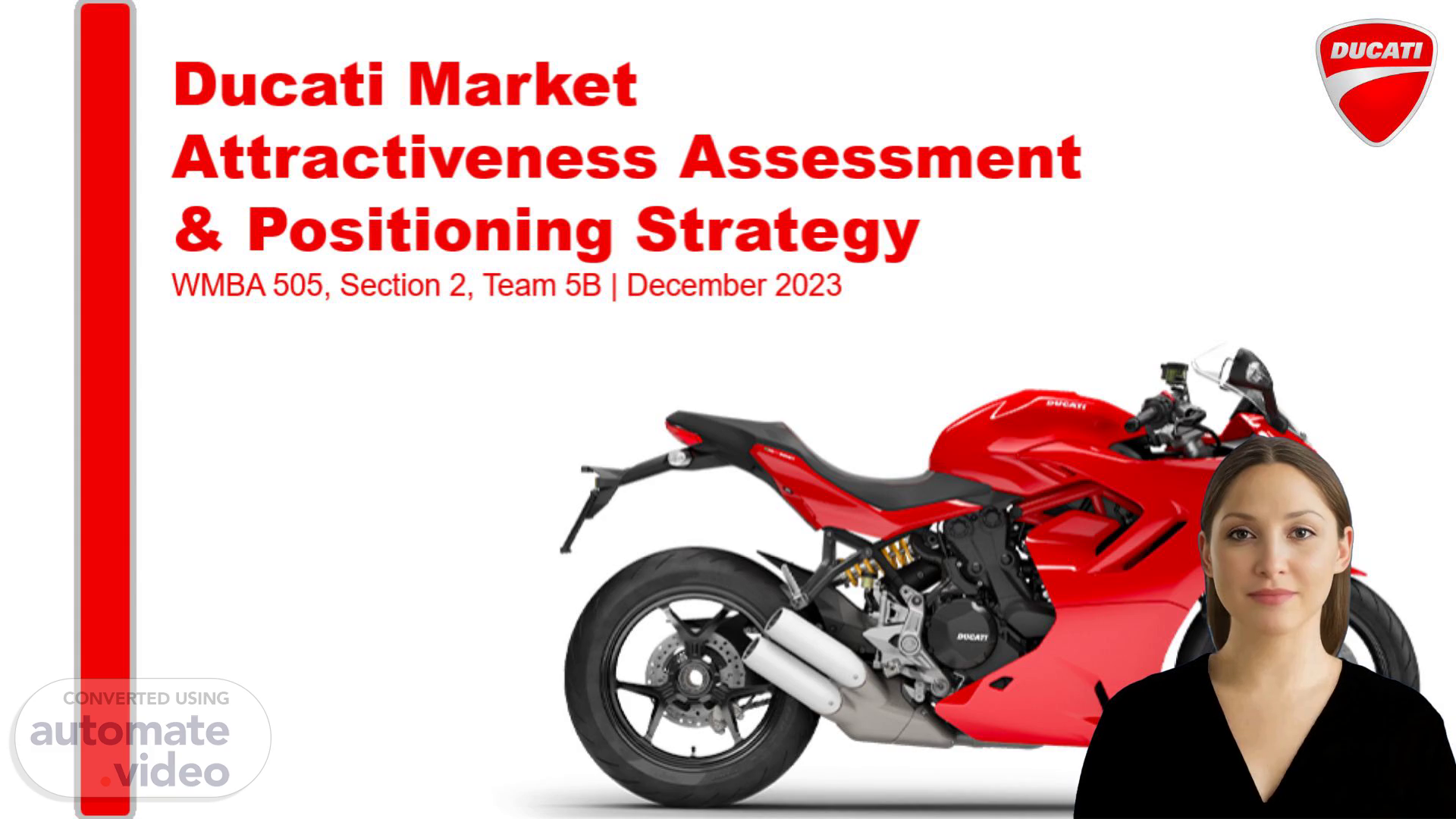
Page 1 (0s)
[Virtual Presenter] Welcome, everyone. Today, we are here to present our assessment of Ducati's market attractiveness and positioning strategy. We will discuss Ducati's corporate strategy and position in the sports segment, as well as the associated risks and tradeoffs. Let's begin..
Page 2 (21s)
[Audio] We can now proceed to the second slide of our presentation, focusing on our team overview and objectives. We will give you a general understanding concerning Ducati's corporate strategy and positioning within the sport segment. Additionally, we will present our suggestions, potential risks and tradeoffs, and our planned future steps and direction. Let us get into the details..
Page 3 (49s)
Team Overview. Profile photo of Preetish Jaiswal.
Page 4 (1m 5s)
[Audio] In the 1980s, Ducati's situation worsened. In 1997, they launched a campaign to spread the brand's reputation and started museum activities. A year later, Texas Pacific Group put money into Ducati and in 1985 Caviga purchased the company, with Minoli as the new CEO. He launched a corporate strategy consisting of accessories and apparel sales, revised distribution methods, and production changes. As a result, Ducati.com sold its first motorbikes online and attempted to penetrate the Harley-Davidson-led cruiser market..
Page 5 (1m 46s)
[Audio] Federico Minoli, Ducati's CEO and Managing Director, implemented a corporate-level strategy at the turn of the millennium, with three components: new, more efficient and effective operating activities, an innovative one-of-a-kind online platform, and the concept of a 'world of Ducati'. This strategy enabled an expansion of their customer base, the opening of new market opportunities, and improved quality and reliability of their products and services. It also resulted in decreased costs due to better supplier management practices, vertical integration of core competencies, and outsourcing of less significant areas. Through Minoli's strategic vision, Ducati rose to become the second most profitable motorcycle maker in the world, despite their size in comparison with competitors..
Page 6 (4m 35s)
[Audio] Analysis of Ducati's market attractiveness and positioning strategy has indicated some significant findings. Ducati has a greater rate of consumer intent to buy again, due to its strong attendance in competitions and victories, permitting it to sustain its standing with patrons. Additionally, the cost of Ducati is in line with the segment's Willingness-to-Pay (WTP) and the extensive tactics and products of Japanese manufacturers do not offer any benefit to impede Ducati's growth. Furthermore, Ducati has been prospering in incorporating performance elements from its R&D into its products, which is correlated to racing and advertising. All these segments and strategies let Ducati to be the leader in the sport segment, and Japanese manufacturers cannot prevent Ducati's increase..
Page 7 (5m 28s)
[Audio] Ducati needs to pursue a two-pronged approach to remain competitive. Firstly, to expand on the World of Ducati to reach more riders and secondly, to strengthen their value chain. This involves bringing production in-house where possible and increasing the number of company-owned stores. This will help strengthen Ducati's existing relationships and lead to increased market competitiveness..
Page 8 (7m 47s)
[Audio] Proposed is a strategy to build and solidify the Ducati brand, form beneficial partnerships, and broaden the customer base. To accomplish this, it is suggested that a Ducati brand magazine be implemented, the online forum community be grown, a Ducati driving school created, the product portfolio expanded with children’s toys and celebrity endorsements, and risk associated with market expansion be mitigated. Implementing these strategies would increase customer willingness to pay and market share for the Ducati brand..
Page 9 (8m 23s)
[Audio] We have conducted a thorough market attractiveness assessment and positioning strategy for Ducati. The company has firmly established its identity through its iconic logo and brand symbol, making it easily recognizable and strongly associated with luxury and excellence. We have discussed the history, purpose, and possible ramifications of the Ducati logo and symbol and hope our analysis provided you with a better grasp of Ducati's position in the market. Appreciate your time and interest in our presentation..